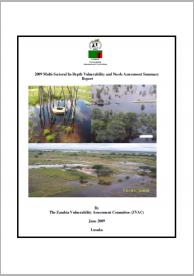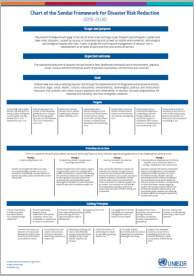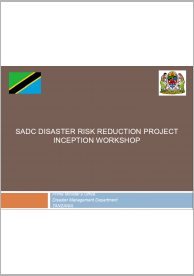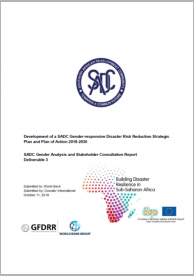
Determine the impact of the 2008/9 floods on various sectors of the economy (Summary Report).
The following is a list of all conten labeled as "Disaster Risk Management"

Determine the impact of the 2008/9 floods on various sectors of the economy (Summary Report).

Zambia presentation in the Strengthening Disaster Risk Reduction, Coordination, Planning and Policy Advisory Capacity of SADC Project Inception Workshop, held in Johannesburg, South Africa, 20-24 January 2020.

Risk-informed development allows for development to become a vehicle to reduce risk, avoid creating risks and build resilience. Only resilient development can become sustainable development; sustainable development initiatives will fail unless they are risk-informed. Risk, resilience and sustainability knowledge and actions need to go hand-in-hand.

The purpose of this note is to support Member States in the operationalization of the global indicators to measure progress towards the achievement of the global targets of the Sendai Framework and relevant targets of the Sustainable Development Goals.

The Sendai Framework for Disaster Risk Reduction 2015-2030 was adopted by UN Member States on 18 March 2015 at the Third UN World Conference on Disaster Risk Reduction in Sendai City, Miyagi Prefecture, Japan.
The Sendai Framework is the first major agreement of the post-2015 development agenda, with seven targets and four priorities for action.

These easy look-up charts outline the Sendai Framework for Disaster Risk Reduction 2015-2030.

Tanzania presentation in the Strengthening Disaster Risk Reduction, Coordination, Planning and Policy Advisory Capacity of SADC Project Inception Workshop, held in Johannesburg, South Africa, 20-24 January 2020.

The Risk, Vulnerability and Capacity Assessment (RVCA) for Kilosa district aimed to identify disaster risks, vulnerability and capacities in the district. The findings from the RVCA form the basis for the preparation of the District’s Emergency Preparedness and Response Plan (DEPRP).

The Disaster Vulnerability Assessment Phase two study is aimed at determining the type, location and frequency of the disasters at national and regional level. To identify the current capacity and coping systems (organizational arrangement) at national and regional level.

This report for SADC summarizes the findings of the gender analysis of the SADC Secretariat and member states.